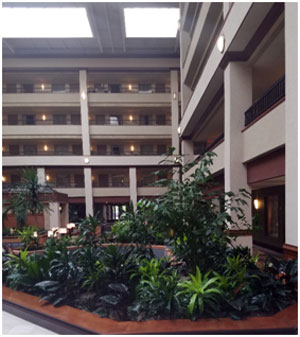Integrated Pest Management Tactics
Prevention
 Always inspect new plants for potential pest and disease problems before they are introduced into the interiorscape. Avoid using plants that appear unhealthy or damaged. These problems should be corrected before their use in an interiorscape. Become familiar with the potential pest and disease problems with the types of plants you manage. Highly susceptible plants can serve as indicator plants to alert you to developing problems.
Always inspect new plants for potential pest and disease problems before they are introduced into the interiorscape. Avoid using plants that appear unhealthy or damaged. These problems should be corrected before their use in an interiorscape. Become familiar with the potential pest and disease problems with the types of plants you manage. Highly susceptible plants can serve as indicator plants to alert you to developing problems.
[return]
Sanitation
Sanitation is an important component of an integrated approach to pest and disease control. This term refers to the cleanliness approach to excluding and eradicating diseases and pests to eliminate or reduce spread. Exclusion is the first step of a good sanitation program. Avoid introduction of infected or infested material. Once diseases or pests are confirmed in an interiorscape, sanitation methods can reduce their populations and limit spread to healthy plant material. Affected plant tissue should be removed promptly. Heavily infested or diseased plants need to be removed from the interiorscape to reduce spread to other healthier plants. Plant debris should be promptly collected and disposed of. Tools used to prune, replant and care for plants need to be regularly cleaned and sanitized.
[return]
Biological Control
Interest in biological control in indoor landscapes has expanded in recent years because of restrictions placed on interiorscape pesticide applications, pesticide costs, poor control with pesticide products, phytotoxicity, need to repeat applications, and potential human health hazards. Biological control relies on parasitoids, predators, or pathogens to suppress insect and mite pest populations, as well as some fungal diseases. Biological agents are usually released and become established before pest population increase to damaging levels. For some biocontrol agents, they may need to be released periodically. To be successful at managing pest problems with biological control agents requires a proper identification of pests, knowledge of the biology of the pest species, the biological control agent(s), and a great deal of time and commitment. Biological control programs do not look after themselves and need to be maintained properly to be successful.
Here are some examples of biological control agents that are commercially available against specific pests:
| Pest |
Biological Control Agent |
Description |
| Spider mites |
Phytoseiulus persimilis |
Predator mite that develops twice as fast as two-spotted spider mites |
| Mealybugs |
Cryptolaemus montrouzieri |
Mealybug destroyer,a small lady beetle. |
| Whiteflies |
Encarsia formosa
Eretomocerus eremicus |
Two tiny wasp parasitoids depending on the species of whitefly:
E. formosa for silverleaf whitefly,
E. eremicus for greenhouse whitefly
|
| Aphids |
Aphidoletes aphidimyza, Aphelinus abdominalis, Aphidius colemani, and Aphidius ervi. |
Several tiny wasp parasitoids |
| Thrips |
Amblyseius swirskii
Neoseiulus cucumeris |
Predatory mites |
| Steinernema feltiae |
Predatory nematode |
| Fungi |
Bacillus amyloliquefaciens, Bacillus subtilis, Bacillus pumilus, Streptomyces lydicus, Trichoderma harzianum. Potassium bicarbonate, hydrogen peroxide. |
Bacteria |
[return]
Resistance to Pests and Disease
Selecting plant species or varieties that are less susceptible to recurring pests and diseases can help to reduce their impact and reliance on pesticides. Proper horticultural care of the plants will also minimize plant stress and help plants better maintain their own defenses. Be careful to avoid over- or under-watering of plants. Interiorscapes are inherently stressful on plants, so try to minimize those stresses on plants. Plants may need to be swapped out so that they can recover from long periods in an interiorscape.
[return]
Regular Monitoring for Pests and Diseases
Develop a routine to monitor regularly using a consistent method. Look on the undersides of leaves, on stems and branches for early signs of developing problems. Keep written records of what you observe so that you are able to detect trends over time. If you can’t identify what is causing a problem, take samples to or contact your local Extension Service office.
A written log should be kept of pest type, locality, abundance, and all pesticides applied. Such records can be of long-term benefit as many pests tend to appear at about the same time each year. However, the short-term benefits of written records may be greater. Knowing what pests survive a pesticide application alerts the manager to the possibility of poor timing, poor application, or pesticide resistance in the pest population. A change in strategy, application technology, or type of pesticide can be made before the plants are significantly damaged.
[return]
Pesticides
Thorough, timely applications of properly labeled pesticides are another important aspect of an integrated pest control program. Rotating infested plants back into a greenhouse where they can be treated thoroughly and revived in vigor before being returned to the indoor landscape is a sound practice but may not be practical with all plants. Treat commercial landscape areas at night, on weekends, or when a minimum number of people are present. The public should not be allowed in the vicinity of treated plants until the pesticide residue on the foliage has dried completely.
Keep written records of all pesticides applied. Regularly rotate among pesticide groups to change modes of action to slow the development of resistance to a particular pesticide.
[return]


